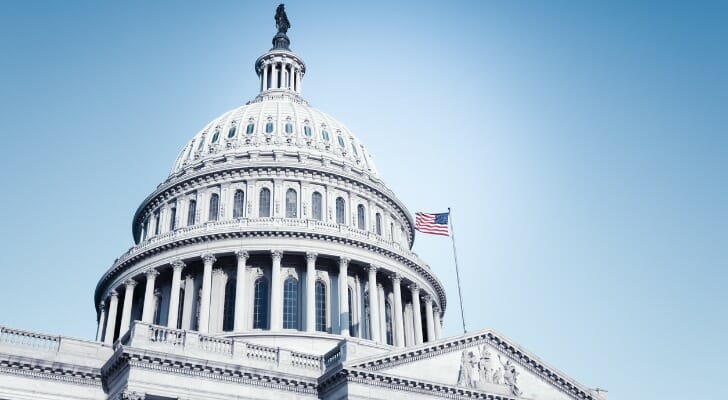The 2019 Setting Every Community Up for Retirement Enhancement (SECURE) Act brought key changes to laws governing retirement plans. Among other things, the Act eliminated the age cutoff for traditional IRA contributions and increased the age for required minimum distributions (RMDs) from 70.5 to 72. The SECURE 2.0 Act would further adjust retirement laws to make saving more accessible for Americans. Whether you’re saving enough to generate a good retirement income – or struggling to – it helps to understand how the SECURE 2.0 Act might affect you.
If you’re concerned about your retirement and want to make sure you’ll have enough money, consider working with a financial advisor to start planning for retirement now.
What Did the SECURE Act Do?
The original SECURE Act passed in 2019 made several reforms to laws regarding retirement plans. Specifically, here’s what the act did for retirement savers:
- Ended the maximum age for contributing to a traditional IRA (Roth IRAs have no age maximum if you have earned income)
- Raised the RMD age threshold to 72 from 70.5
- Enabled certain part-time employees to participate in their company’s 401(k) plans
- Allowed for penalty-free withdrawals of up to $5,000 from retirement accounts when those funds are used for qualified birth or adoption expenses
- Allowed parents to make withdrawals of up to $10,000 from qualified 529 college savings plans for student loan repayment
In a nutshell, the SECURE Act has made it easier to save in a traditional IRA if you’re still working and choose to delay retirement. You’re no longer shut out from contributing to a 401(k) plan to enjoy tax benefits while saving from retirement simply because you work on a part-time basis. And it’s also easier to withdraw money from retirement accounts when funds are used for purposes allowed under the SECURE Act.
So, what will the SECURE 2.0 Act do and what could it mean for your retirement?
SECURE 2.0 Act Explained
The SECURE 2.0 Act that’s currently working its way through Congress would bring additional changes to retirement planning, some more notable than others. If it becomes law, here’s what you could expect.
Mandatory Auto-Enrollment for Defined Contribution Plans
Under SECURE 2.0 Act, employers that offer defined-contribution plans such as 401(k)s would be required to enroll eligible new employees automatically. Those employees would be enrolled at a contribution rate of 3%, similar to the way many 401(k) plans operate now. But the annual contribution level would automatically be increased by 1% each year, maxing out at 15% of employee pay unless employees choose a different contribution rate. Employees can opt not to be enrolled.
This measure is designed to boost 401(k) plan participation rates and help workers increase retirement savings.
New Catch-Up Contribution Limits for 401(k) Plans
Employer-sponsored 401(k) plans have annual contribution limits, with separate catch-up contribution limits allowed for savers aged 50 and older. For 2022, the regular contribution limit is $20,500 ($22,500 in 2023) while the catch-up contribution limit is an additional $6,500 ($7,500 in 2023). SECURE 2.0 Act would introduce another catch-up contribution limit just for people aged 60 to 63. The limit would take effect after December 31, 2024 and would be the greater of two: either $10,000 or 150% of the regular catch-up amount for those age 50 and older.
Expanded 401(k) Eligibility
The 2019 SECURE Act allows part-time workers who log at least 500 hours over three consecutive years to join their employer’s 401(k) plan. Under SECURE 2.0 Act, they’d still need 500 hours but they could earn them over two consecutive years instead of three.
Increased Age for RMDs
The SECURE Act already pushed required minimum distributions back to age 72. SECURE 2.0 Act would push them back even further to age 73 beginning on January 1, 2023. And, beginning in 2032, savers would not be required to take RMDs until age 75.
Student Loan Match
One unique facet of the latest version of the SECURE Act would allow employers to make matching contributions to 401(k) plans based on employees’ student loan payments. These contributions would be subject to the same vesting requirements as other matching contributions. But it could offer some financial relief to workers who are so bogged down in student loan debt that they struggle to save anything for retirement.
Other Changes Under Secure 2.0
There are a few other provisions to know about with SECURE 2.0 Act. The expanded legislation would also establish a national database to help Americans track down lost or missing retirement accounts. It would require the Treasury to make people more aware of the Retirement Saver’s Credit and how to claim it if they qualify. This credit can reduce tax liability for eligible retirement savers who qualify.
Additionally, the Act would carry over certain features of 401(k) plans to 403(b) plans. And it would make it easier for retirement plans to offer lifetime income annuities to savers. Annuities can be attractive for people who want to have a source of guaranteed income in retirement.
What SECURE 2.0 Act Doesn’t Do
SECURE 2.0 Act could make saving for retirement more accessible but it doesn’t necessarily make it easier. That’s because the retirement legislation doesn’t specifically address things like stagnating wages, increasing rent prices or a higher cost of living associated with inflation, all of which can make contributing to a 401(k) or IRA difficult. The Act does try to mitigate some of the financial burden associated with student loan debt but it doesn’t make withdrawing money from a 401(k) or IRA penalty- or tax-free easier.
The new version of the SECURE Act doesn’t make IRA savings automatic either. So if you don’t have a 401(k) at work and an IRA is your only savings option, you’ll still need to be disciplined about regularly saving yourself. But that’s easy to do if you open an IRA through an online brokerage account. You can simply schedule automatic deposits to your IRA weekly, biweekly or monthly, according to how often you get paid.
Bottom Line
SECURE 2.0 Act can be a game-changer of sorts when it comes to retirement saving. If you haven’t started saving for retirement yet, there’s no time like the present to begin building wealth for the future through your employer’s retirement plan or an IRA.
Retirement Planning Tips
- Creating a well-rounded retirement picture starts with figuring out how much you need to save. Using a retirement savings calculator can help you estimate how much you need to set aside monthly or annually to reach your target retirement goals. Including tax-advantaged retirement plans, such as a 401(k) or IRA, in your savings strategy can help you make the most of every dollar you contribute. It’s also important to check your investment fees regularly, as fees can eat into your earnings.
- Consider talking to your financial advisor about what SECURE 2.0 Act could mean for your savings strategy. If you don’t have a financial advisor yet, finding one doesn’t have to be difficult. SmartAsset’s financial advisor matching tool makes it easy to connect with professional advisors in your local area. It takes just minutes to get your personalized recommendations online. If you’re ready, get started now.
Photo credit: ©iStock.com/uschools, ©iStock.com/DNY59, ©iStock.com/AscentXmedia


